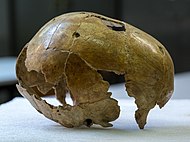Engis 2

Engis 2 is the name for a partially preserved skull roof with a presumably associated, also partially preserved upper jaw of a two to three year old Neanderthal child. The fossil was discovered in 1829 along with several other bones in the Avir II cave just north of the Belgian municipality of Engis . In 1833 their excavator, the Dutch doctor and naturalist Philippe-Charles Schmerling , described these skeletal remains in a specialist publication and assigned them to the " Diluvium " as he recognized their great age from fossils of extinct animal species and stone tools that were also discovered . However, it was not recognized until 1936 that this publication contained the first scientific description of a Neanderthal fossil.
Initially, Fossil Engis 2 received little attention compared to Fossil Engis 1 - the very well and almost completely preserved skull of an adult, anatomically modern human ( Homo sapiens ) - and it was also misunderstood as "modern". Although Carl von Linné had already introduced the designation Homo sapiens as a species name for humans in the 10th edition of his writing Systema Naturae (p. 20) in 1758 , but without a so-called diagnosis , i.e. without a precise description of the species-typical characteristics. Therefore, in the early 19th century, the criteria by which one could distinguish fossil species of the genus Homo from Homo sapiens were still missing . Even Thomas Henry Huxley , a supporter of Darwin's theory of evolution , as recently as 1863 ascribed the find from Engis to a "man of low degree of civilization" and interpreted the find Neandertal 1 from the Neandertal as lying within the range of variation of modern humans. In addition, the skulls of a very young Neanderthal man and a child of about the same age in anatomically modern humans are much more similar than the skulls of adults, “and it was wrongly believed that a verifiably modern skull from the Engis cave [Engis 1 ] was associated with the child's skull. "
An exact dating of the finds from Engis is still pending. Engis 2 was assigned to Homo neanderthalensis and Engis 1 to Homo sapiens was primarily based on their anatomical features; Engis 2 was also recovered from the Moustérien in the context of artefacts .
In 1986, incisions on the top of the skull bones were interpreted by Engis 2 in a specialist article as cutting traces and, among other things, assumptions about cannibalistic actions were derived from them. In 1989 these hypotheses were refuted by Tim White with reference to various other fossils as consequences of damage to the skull during preparation.
The finds from Engis are kept at the Service de Paléontologie Animale et Humaine of the University of Liège . The bone fragments designated as Engis 3 are missing . The phylogenetic origin of an Ellen fragment (Engis 4) discovered in 1872 is unclear; it has not yet been assigned to any taxon .
Web links
Individual evidence
- ^ Philippe-Charles Schmerling : Recherches sur les ossements fossiles découverts dans les cavernes de la Province de Liège. P.-J. Collardin, Liège 1833, pp. 1-66
- ↑ Charles Fraipont: Les Hommes Fossiles d'Engis. In: Archives de l'Institute de Paléontologie Humaine. Mémoire 16, 1936, pp. 1-52
- ↑ Thomas Henry Huxley : On some fossil remains of man. Chapter 3 in: Evidence as to man's place in nature. D. Appleton and Company, New York 1863
- ↑ Ian Tattersall : Neanderthals. The dispute about our ancestors. Birkhäuser Verlag, Basel 1999, p. 78, ISBN 3-7643-6051-8
- ^ Bernard Wood : Wiley-Blackwell Encyclopedia of Human Evolution. Wiley-Blackwell, 2011, ISBN 978-1405155106
- ^ Mary D. Russell and Françoise LeMort: Cutmarks on the Engis 2 calvaria? In: American Journal of Physical Anthropology. Volume 69, No. 3, 1986, pp. 317-323, DOI: 10.1002 / ajpa.1330690304
- ^ Tim D. White and Nicholas Toth: Engis: Preparation damage, not ancient cutmarks. In: American Journal of Physical Anthropology. Volume 78, No. 3, 1989, pp. 361-367, DOI: 10.1002 / ajpa.1330780305

